Your guide to Freestanding Baths in NZ
Monday 08 May 2023
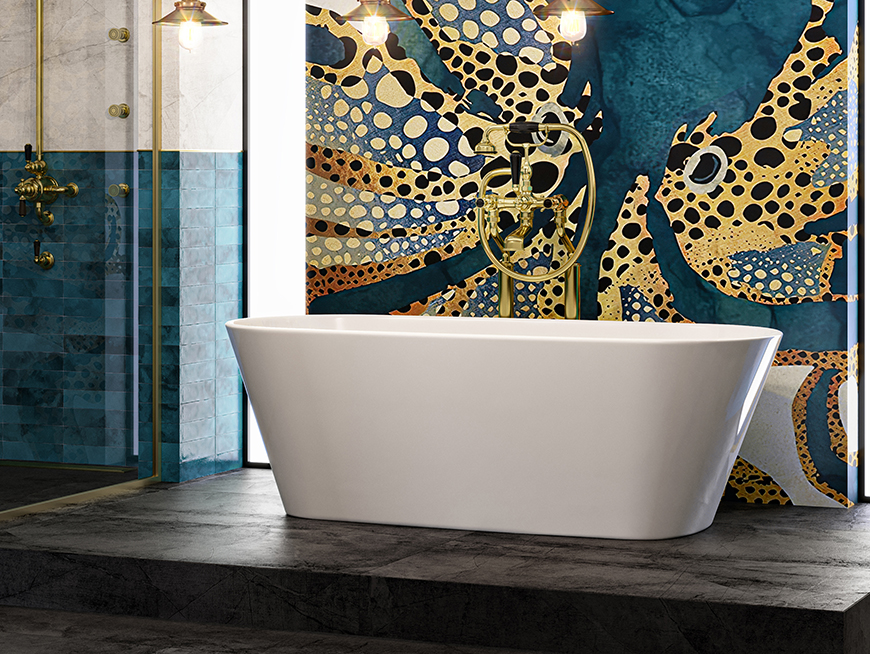
Freestanding baths have become increasingly popular in recent years, offering a luxurious and spa-like experience in the comfort of your own home. In New Zealand, freestanding baths are a popular choice for homeowners who are looking to upgrade their bathrooms and add a touch of elegance and style to their homes. In this guide, we’ll cover everything you need to know about freestanding baths in New Zealand, including the different types available, installation considerations, and maintenance tips.
Types of Freestanding Baths
There are several types of freestanding baths available in New Zealand, each with its own unique features and benefits. Here are some of the most common types:
1. Clawfoot Freestanding Baths
Clawfoot freestanding baths are a classic design that originated in the late 19th century. They feature ornate feet that elevate the bathtub off the ground and give it a vintage look. Our Clawfoot baths are made from Quarrycast which retains heat well, making it a popular choice for those who want a long, relaxing soak.
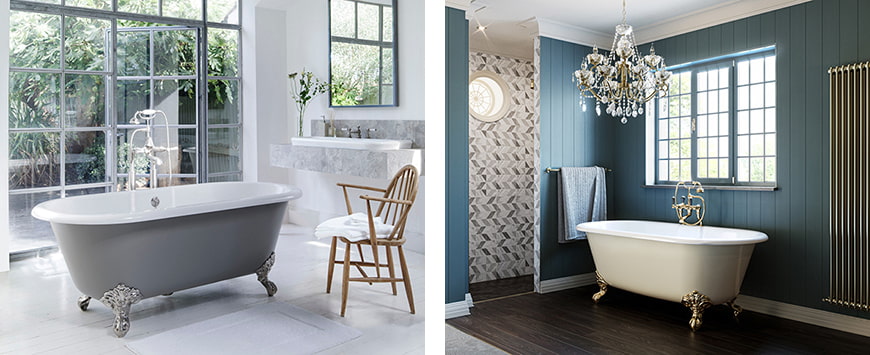
2. Modern Freestanding Baths
Modern freestanding baths are sleek and contemporary in design, often featuring clean lines and smooth curves. They’re available in a variety of materials, including acrylic, stone, and quarrycast, and can be customized to fit any bathroom decor. Modern freestanding baths are a popular choice for those who want a minimalist, spa-like experience.
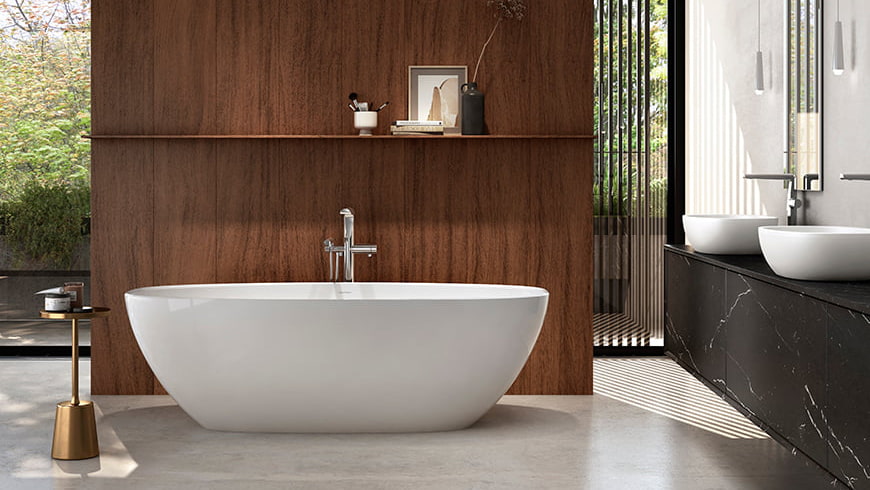
3. Slipper Freestanding Baths
Slipper freestanding baths are similar in design to clawfoot baths but feature a higher backrest on one end, creating a more comfortable reclining position. Slipper baths are often made from acrylic or stone, which retain heat well, allowing you to enjoy a long, relaxing soak.
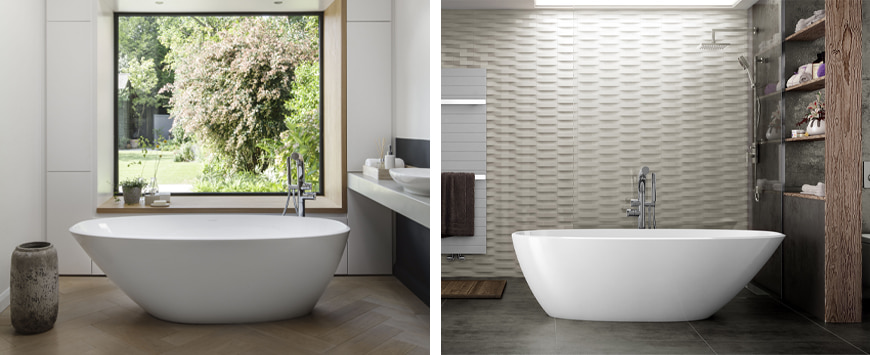
Installation Considerations
Installing a freestanding bath requires careful planning and consideration to ensure that it’s both functional and aesthetically pleasing. Here are some important factors to keep in mind:
Size and Placement
The first step in installing a freestanding bath is to determine the size and placement. Freestanding baths come in a range of sizes, so it’s important to choose one that fits comfortably in your bathroom without overpowering the space. It’s also important to consider the placement of the bath and ensure that it doesn’t block any doors or windows.
Plumbing and Drainage
Freestanding baths require a separate supply of hot and cold water and a drainpipe that’s connected to the main plumbing system. Depending on the location of the bath, you may need to run new pipes and drainage lines, which can add to the cost of installation. Some freestanding baths also come with an in-built void to allow for above floor plumbing to be installed, such as the Victoria & Albert Barcelona and Mozzano.
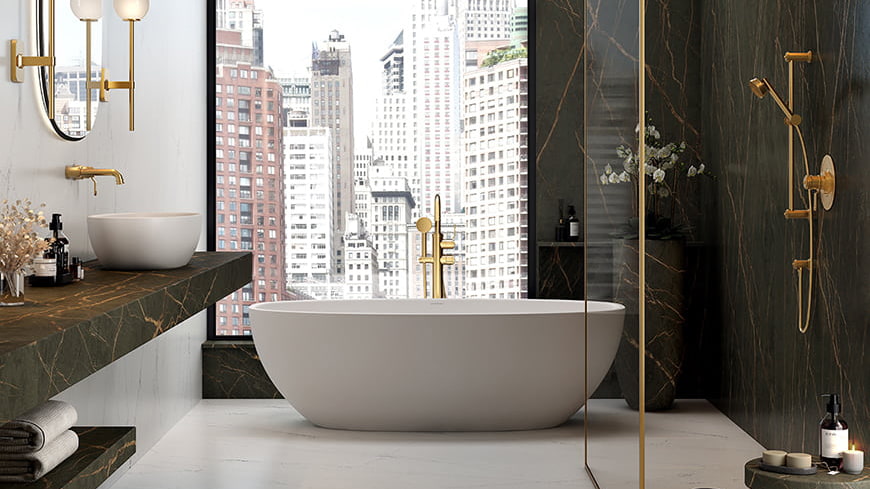
Flooring
Freestanding baths are heavy, so it’s important to ensure that your bathroom flooring can support the weight of the bath. If you have a timber floor, you may need to reinforce it with additional support.
Ventilation
Baths create steam, which can lead to mould and mildew if not properly ventilated. Ensure that your bathroom has adequate ventilation to prevent any moisture build up.
Maintenance Tips
Maintaining a freestanding bath is relatively easy and straightforward, but it’s important to follow some basic guidelines to keep it looking and functioning its best. Here are some tips:
- Cleaning - Regular cleaning is essential to prevent the build-up of soap scum and mineral deposits on the surface of the bath. Use a non-abrasive cleaner and a soft cloth or sponge to wipe down the bath after each use.
- Avoid harsh chemicals - Harsh chemicals can damage the surface of a freestanding bath, so it’s important to avoid using abrasive cleaners or chemicals that contain bleach or ammonia.
- Refinishing - Over time, the surface of a freestanding bath may become worn or discoloured. If this occurs, refinishing the bath may be an option. Refinishing involves applying a new coating to the surface of the bath to restore its original appearance. However, this process should only be done by a professional to ensure that the coating is applied correctly and that the bath is safe to use. It's important to note that refinishing is not a permanent solution and may need to be repeated every few years, depending on the usage of the bath.
- Avoid scratches - Freestanding baths can be scratched easily, so it’s important to avoid using abrasive sponges or brushes. Instead, use a soft cloth or sponge to clean the surface.
- Check for leaks - Regularly check the plumbing and drainage connections to ensure that there are no leaks. Leaks can cause water damage to your bathroom and can also result in increased water bills.
- Use a bathmat - A bathmat can prevent slips and falls in the tub and also protects the surface from scratches and damage caused by abrasive materials.
- Keep the bath dry - After each use, wipe down the bath with a towel to remove any excess water. This prevents moisture build up and prevents mould and mildew from growing.
Freestanding bath FAQs
Do you need to waterproof under a freestanding bath?
Yes, it is important to waterproof under a freestanding bath. When water splashes over the sides of the bath or leaks from the plumbing, it can seep into the subfloor and cause damage over time. This can lead to mould growth, wood rot, and other problems that can be costly to repair.
To prevent this, a waterproof membrane should be installed under the bath to create a barrier between the bath and the subfloor. This membrane should extend up the walls of the enclosure to prevent water from seeping through any gaps between the bath and the wall. The membrane should also be installed in a way that ensures that any water that gets under the bath is directed towards the drain.
It's important to ensure that the waterproofing is done correctly before the bath is installed. If you're unsure about how to waterproof your bathroom, it's best to consult with a professional to ensure that it's done correctly.
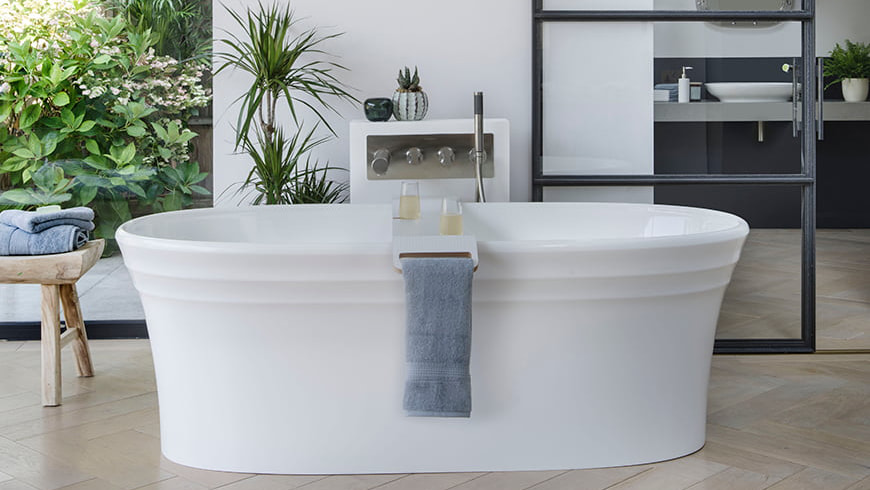
Is it hard getting in and out of a freestanding bath?
Getting in and out of a freestanding bath can be more difficult than getting in and out of a built-in bathtub. This is because freestanding baths are not typically installed at the same level as the bathroom floor, so you may need to step up or down to get in and out of the bath.
The height of the bath can also be a factor. Some freestanding baths can be quite tall, which can make it difficult for people with mobility issues to use them safely.
However, there are ways to make getting in and out of a freestanding bath easier. For example, you can install a step stool or grab bars to provide support and stability. You can also choose a freestanding bath with a lower profile, or one that has a ‘void space/cavity’ as this means the base is raised off the floor making transfer in/out of the bath easier.
Overall, the ease of getting in and out of a freestanding bath will depend on the specific bath and your individual needs and abilities. It's important to consider these factors when choosing a freestanding bath to ensure that it's a safe and comfortable option for you.
Can you put a freestanding bath in a small bathroom?
Freestanding baths can be a great addition to small bathrooms, but it's important to choose the right size and style to ensure that it doesn't overwhelm the space.
One factor to consider is the size of the bath. Freestanding baths come in a variety of sizes, so it's important to measure your bathroom and choose a bath that fits comfortably within the space. You'll also need to consider the placement of the bath, as it will need to have enough clearance around it for people to move comfortably.
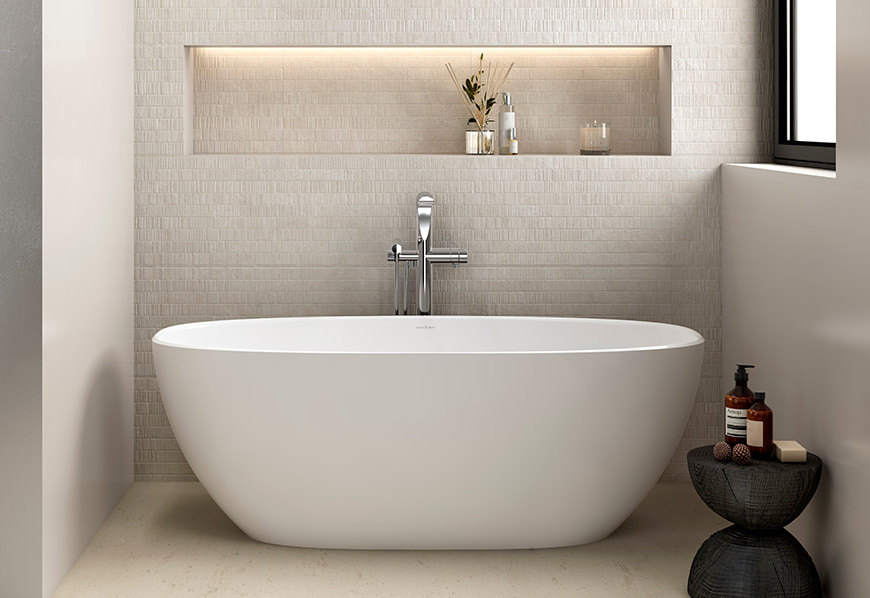
Another factor to consider is the style of the bath. Some freestanding baths have a more traditional, ornate design that can take up more visual space, while others have a more modern, minimalist design that can blend in more easily with a small bathroom. Choosing a bath with a lighter colour can also help to make the space feel more open and airy.
Overall, with careful planning and consideration, it's possible to incorporate a freestanding bath into a small bathroom. Just be sure to choose a bath that fits the space and complements the overall style of your bathroom.
Are freestanding baths hard to clean around?
Freestanding baths can be slightly more difficult to clean around than built-in bathtubs because they have an exposed exterior that can collect dust and debris. However, with the right tools and techniques, cleaning a freestanding bath can be just as easy as cleaning a built-in bathtub.
One way to make cleaning a freestanding bath easier is to choose a design that has a smooth, flat surface on the exterior. This can make it easier to wipe down and clean with a damp cloth or sponge. Avoid designs with ornate details or crevices that can collect dirt and grime.
Another tip is to use a soft cloth or sponge to clean the surface of the bath. Avoid using abrasive cleaners or brushes, as they can scratch or damage the surface of the bath.
To clean around the base of the freestanding bath, you can use a handheld vacuum or a broom to sweep up any dust or debris. A small handheld dustpan can also be helpful for collecting any debris that falls on the floor.
Can a freestanding bath be up against a wall?
Yes, a freestanding bath can be up against a wall. In fact, many freestanding baths are designed to be placed against a wall, with the exposed side facing outward. This can create a unique and stylish look in your bathroom.
It's also important to consider the placement of the plumbing when installing a freestanding bath against a wall. The plumbing will need to be installed in a way that allows for easy access for maintenance and repairs.
Finally, you'll want to consider the design of the bath when placing it against a wall. Some freestanding baths have a more decorative exterior on the exposed side, while others have a flat, smooth surface that's designed to be placed against a wall. Be sure to choose a bath that's designed to be installed in the way that you prefer.
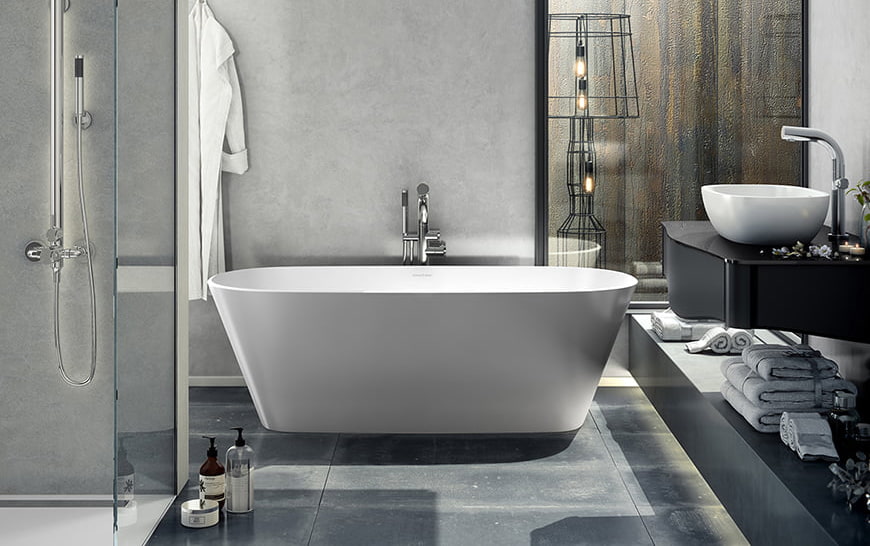
Do you need to tile behind a freestanding bath?
Whether or not you need to tile behind a freestanding bath depends on a few factors.
If the freestanding bath is positioned in a way that exposes the wall behind it, it's a good idea to tile the area to protect it from water damage. Water can splash onto the wall and cause damage if it's not properly protected. Tiling the wall behind the bath can also make it easier to clean and maintain.
However, if the freestanding bath is positioned in a way that doesn't expose the wall behind it, such as when it's placed in a corner or against a wall, it may not be necessary to tile the area. In this case, you can simply paint or wallpaper the wall as you would with any other part of the bathroom.
Another factor to consider is the style of the bathroom. If you want to create a cohesive and polished look, tiling behind the freestanding bath can be a great way to tie the design elements of the bathroom together.
Will freestanding baths go out of style?
Freestanding baths have been a popular choice for bathrooms for many years and are unlikely to go out of style anytime soon. They offer a timeless and elegant look that can complement a variety of bathroom styles and designs.
In recent years, freestanding baths have become even more popular as homeowners and designers seek to create spa-like environments in their bathrooms. This trend is likely to continue, as more and more people prioritize relaxation and self-care in their daily routines.
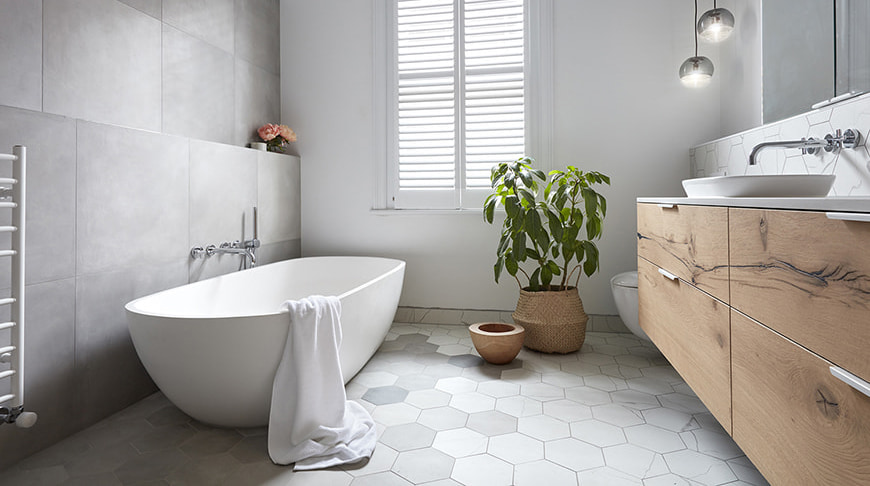
However, it's worth noting that certain styles of freestanding baths may fall out of favour over time. For example, designs with very ornate details or unusual shapes may not be as popular in the future as they are today. To ensure that your freestanding bath remains in style for years to come, it's a good idea to choose a design that's classic and timeless, rather than overly trendy or fashionable.
Summary
Freestanding baths are a luxurious addition to any bathroom, offering a spa-like experience in the comfort of your own home. In New Zealand, there are many different types of freestanding baths available, each with their own unique features and benefits. Before installing a freestanding bath, it’s important to consider factors such as size, placement, plumbing, drainage, and ventilation. With proper maintenance and care, your freestanding bath can provide many years of relaxation and enjoyment.